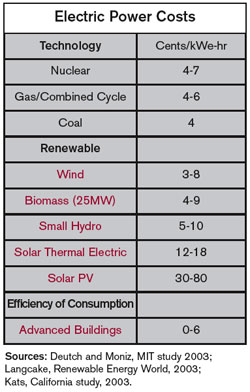
| Vol.
XVIII No.
5 May / June 2006 |
| contents |
| Printable Version |
Efficient Use of Energy:
Part of MIT's New Energy Initiative
As part of the new energy initiative outlined in the Energy Research Council report, there is the need through MIT’s future research and the development of our built environment to assume the leadership in the field of energy efficiency. Many institutions, such as policymakers in Washington, have concentrated on the energy problem from the supply side. Indeed, in our recent Energy Forum, a majority of the speakers dealt with present and future energy supply technologies. Rather than concentrating on a supply-side solution, it makes more sense to have a balanced approach that also emphasizes means to limit consumption.
Residential and commercial buildings constitute the largest energy consumption sector of the U.S. Buildings use almost 40 percent of our total energy, and are larger than the transportation sector by far. Buildings also consume two-thirds of our total electricity. Most of the energy used in buildings is used to meet basic requirements for heating, cooling, ventilation, and lighting. Buildings have a long lifetime, 50 to 100 years, so that errors we make now will be with us for a long time; unfortunately, there are some recent examples here on campus. For example, each fume hood left open consumes as much energy for heating and electricity as a single family home in Boston.
The issue of efficient buildings is particularly acute in the developing world where there is a massive construction effort underway. For example, China is building more than 10 million new residential units per year!
Proper actions in the urban and regional environment here and abroad can yield substantial immediate as well as long-term results. Over a longer time horizon, major new steps can be taken to reduce energy consumption. Research underway at MIT will lead to comfortable northern homes without heating systems, office buildings naturally ventilated in the summer as well as advanced daylighting systems that save more than half of the energy now used for lighting. It is not unrealistic to expect projects in the built environment that make economic sense while delivering a factor-of-two increase in overall energy efficiency over present buildings.
A handful of demonstration buildings have begun to appear, especially in Europe, which herald major improvements in energy efficiency. Generally these utilize technologies that have a narrow focus and have not been well thought out from a whole building or urban development sense. Many demonstrations include a mix of several technologies, some seemingly because they “look green” even though not economically justifiable. There is a wide spread between the energy consumption per unit floor area of best-practice buildings and average new buildings. Major advances in energy efficiency in the built environment require a broad approach to building research and development. No one “silver bullet” will make a major impact by itself. Rather, substantial improvements in energy efficiency require the development of advanced technologies and an integrated approach to planning, design, optimization, and operation. These must be guided by mid- and long-range policy studies defining approaches that have major beneficial socioeconomic and environmental impacts, are economically viable, and motivate people to follow.
| Back to top |
In many instances it can be shown that the capital costs to improve the energy efficiency of a building are far less than the costs required to provide added energy supplies for a less efficient building. This is particularly true if the building efficiency concepts are included early in the design process for new construction. It is important for MIT to carry out a comprehensive study for our current and future campus development, including future energy demands as well as supply systems. We have the expertise in policy, environmental, and technology issues to put a firm foundation on our ability to “walk the talk.” MIT can be at the forefront, carrying out a comprehensive integrated study that identifies realistic economic measures that reduce specific energy consumption by at least a factor of two for future buildings. I would propose we develop a demonstration building, using such an integrated approach from the outset, as one of the first actions in our proposed new energy initiative.
There is the perception that a sustainable building costs substantially more than a standard building design. If the sustainable features are designed as an integral part of the building system, the capital-cost increase may be minimal, if at all. For example, use of a double-skin façade system may allow the usual perimeter heating and cooling systems to be eliminated. The figure compares the cost for producing electricity from conventional and renewable means to the costs of saving electricity from efficient new building technologies and integrated designs. Bear in mind that the conventional system costs don’t include additional societal costs. It is clear that a focus on efficient energy utilization should be a key element in our future energy studies.
| Back to top | |
| Send your comments |
| home this issue archives editorial board contact us faculty website |
